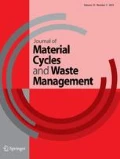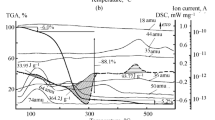Abstract
Important experimental data were obtained for the development of an integrated technology for the destruction of accumulated volumes of environmentally hazardous technical mixtures of polychlorobiphenyls. The proposed technology for the destruction of ecotoxicants includes a chemical and subsequent pyrolytic stages. It was established for the first time that the alkoxy- and hydroxy-derivatives of polychlorobiphenyls obtained by chemical interaction with polyethylene glycols in the presence of alkali and with sodium methoxide contain a reduced amount of chlorine in the structure and are less thermostable compounds in comparison with the initial congeners of the Sovol technical mixture. It was found that heating the Sovol technical mixture leads to the evaporation of toxic polychlorobiphenyl congeners and the release into the atmosphere. During the thermal degradation of the obtained alkoxy- and hydroxy-derivatives of polychlorobiphenyls, there is no evaporation of PCBs congeners, and decomposition to the simplest environmentally acceptable volatile substances (CO2, H2O, HCl, etc.) is observed. Formation of polychlorinated dibenzodioxins and dibenzofurans is not detected. The proposed comprehensive two-stage approach to the destruction of technical mixtures of polychlorobiphenyls requires less energy and is characterized by a significant reduction in the emission of hazardous polychlorobiphenyls.



Similar content being viewed by others
References
Kawamoto K, Mabuchi K (2001) Formation characteristics of polychlorinated dibenzo-p-dioxins, polychlorinated dibenzofurans, and coplanar PCBs in fly ash from a gasification–melting process of municipal solid waste. J Mater Cycles Waste Manag 3:38–47
Vermeulen I, Caneghem JV, Vandecasteele C (2014) Indication of PCDD/F formation through precursor condensation in a full-scale hazardous waste incinerator. J Mater Cycles Waste Manag 16:167–171
Erickson MD, Robert KG (2011) Applications of polychlorinated biphenyls. Environ Sci Pollut Res Int 18:135–151
Borja J, Taleon DM, Auresenia J et al (2005) Polychlorinated biphenyls and their biodegradation process. Biochemistry 40:1999–2013
Porta M, Zumeta E (2002) Implementing the Stockholm treaty on persistent organic pollutants. Environ Med 59:651–652
Zanaveskin LN, Averyanov VA, Treger YuA (1996) Prospects for the development of methods for the processing of organohalogen waste. Characteristic features of the catalytic hydrogenolysis of halogen-containing compounds. Russ Chem Rev 65(7):667–675
Ishikawa Y, Noma Y, Yamamoto T et al (2007) PCB decomposition and formation in thermal treatment plant equipment. Chemosphere 67(7):1383–1393
Karstensen K, Mubarak A, Gunadasa H et al (2010) Test burn with PCB-oil in a local cement kiln in Sri Lanka. Chemosphere 78(6):717–723
Trinh MM, Kuo CH, Chang MB (2019) Characterization of PCDD/Fs and dl-PCBs emission from combustion of PCB-containing oil in a fluidized-bed incinerator. Chemosphere 225:35–42
Liu J, Qi ZF, Li XD et al (2015) Effect of oxygen content on the thermal desorption of polychlorinated biphenyl contaminated soil. Environ Sci Pollut Res 22:12289–12297
Wu B-Z, Hen H-Y, Wang S-J et al (2012) Reductive dechlorination for remediation of polychlorinated biphenyls. Chemosphere 88(7):757–768
Wu J, Zhang P, Wu C et al (2019) Kinetics of 2,3-DCB dechlorination by Pd/Fe-MWCNTs- Fe3O4 nanoparticles synthesized under ultrasonic irradiation. J Phys Conferen Series 1176(5):052065
Shabbir S, Hong M, Rhee H (2017) Resin-supported palladium nanoparticles as recyclable catalyst for the hydrodechlorination of chloroarenes and polychlorinated biphenyls. Appl Organometal Chem 31(2):e3552
Gorbunova TI, Subbotina JO, Saloutin VI et al (2014) Reactivity of polychlorinated biphenyls in nucleophilic and electrophilic substitutions. J Hazard Mater 278:491–499
De Filippis P, Scarsella M, Pochetti F (1999) Dechlorination of Polychlorinated Biphenyls: A Kinetic Study of Removal of PCBs from Mineral Oils. Ind Eng Chem Res 38:380–384
Velazco MZ, Pedroso PGV, Ramos GV et al (2013) Chemical dechlorination for the treatment of PCBs present in transformer oil (Sovtol-10): parameter study. Afinidad 70(563):206–211
Gorbunova TI, Pervova MG, Trushina EB et al (2012) A New Application of Derivatives of Polychlorobiphenyls and Polyethylene Glycols. Russ J Appl Chem 85(10):1622–1626
Plotnikova KA, Pervova MG, Gorbunova TI et al (2017) Optimization of the chemical stage of pretreatment of technical polychlorobiphenyls for destruction. Doklady Chem 476(1):206–210
Kulikova TV, Maiorova AV, Shunyaev KY et al (2013) Thermodynamic modeling of the reaction of polychlorinated biphenyls with sodium methoxide. Russ J Gen Chem 83(5):893–900
Kulikova TV, Maiorova AV, Bykov VA et al (2019) Optimization of nucleophilic dechlorination of polychlorinated biphenyls: calculation and experiment. Int J Environ Sci Technol 16(7):3265–3274
Kamarehie B, Jafari AJ, Mahabadi HA (2014) Dechlorination and decomposition of Aroclor 1242 in real waste transformer oil using a nucleophilic material with a modified domestic microwave oven. J Mater Cycles Waste Manag 16:711–720
D'Antone SS, Bignotti F, Sartore L et al (2011) Thermogravimetric investigation of two classes of block copolymers based on poly(lactic-glycolic acid) and poly(ε-caprolactone) or poly(ethylene glycol). Polym Degrad Stab 74:119–124
Acknowledgements
This work was supported by the Russian Foundation for Basic Research (project no. 18–29–24126) using the equipment of the Center for Shared Use “Spectroscopy and Analysis of Organic Compounds (SAOC)”.
Author information
Authors and Affiliations
Corresponding author
Additional information
Publisher's Note
Springer Nature remains neutral with regard to jurisdictional claims in published maps and institutional affiliations.
Rights and permissions
About this article
Cite this article
Maiorova, A.V., Safronov, A.P., Kulikova, T.V. et al. Synthesis and thermal decomposition of alkoxy-, hydroxy-derivatives of Sovol polychlorbiphenyls technical mixture. J Mater Cycles Waste Manag 22, 1552–1560 (2020). https://doi.org/10.1007/s10163-020-01044-z
Received:
Accepted:
Published:
Issue Date:
DOI: https://doi.org/10.1007/s10163-020-01044-z




